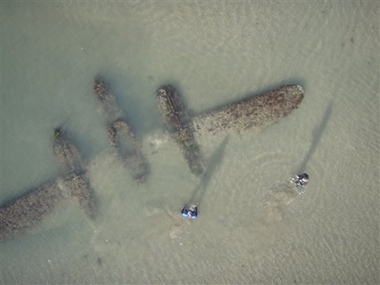prop-er
Forum veteraan
Lockheed P-38 Lightning found on UK beach
Published by Michael November 21st, 2007 in Aviation History and Military.
65 years after an American USAF Lockheed P-38 Lightning ran out of gas and crash-landed on a beach in Wales, the long-forgotten World War II relic has emerged from the surf and sand where it lay buried. The aircraft is believed to be P-38F USAAF serial number 41-7677 assigned to the 49th Squadron, 14th Fighter Group, 8th Air Force. Experts hope to recover the plane for a British military museum.
American Lockheed P-38 Lightning at UK beach

The Wales Lightning, built in 1941, reached Britain in early 1942 and flew combat missions along the Dutch-Belgian coast. On September 27, 1942, fuel exhaustion during a training mission forced 2nd Lt. R. Frederick Elliott to land the large twin-engine fighter in shallow water near a beach in Wales. His belly landing in shallow water sheared off a wingtip, but Elliott escaped unhurt. Less than three months later, the veteran of more than 10 combat missions was shot down over Tunisia, in North Africa. His plane and body were never found.
Following the accident, 8th Air Force authorities disarmed, but did not salvage, the aircraft which was soon covered by the shifting sand beneath the surf. At the time of Lt. Elliott’s mishap, few civilians in the local area were aware of the accident because the beaches in the United Kingdom were closed to the public during World War II and the press was not allowed to print stories about Allied wrecks. After the war, recreational use of the beaches resumed but the Lightning remained hidden.
Published by Michael November 21st, 2007 in Aviation History and Military.
65 years after an American USAF Lockheed P-38 Lightning ran out of gas and crash-landed on a beach in Wales, the long-forgotten World War II relic has emerged from the surf and sand where it lay buried. The aircraft is believed to be P-38F USAAF serial number 41-7677 assigned to the 49th Squadron, 14th Fighter Group, 8th Air Force. Experts hope to recover the plane for a British military museum.
American Lockheed P-38 Lightning at UK beach

The Wales Lightning, built in 1941, reached Britain in early 1942 and flew combat missions along the Dutch-Belgian coast. On September 27, 1942, fuel exhaustion during a training mission forced 2nd Lt. R. Frederick Elliott to land the large twin-engine fighter in shallow water near a beach in Wales. His belly landing in shallow water sheared off a wingtip, but Elliott escaped unhurt. Less than three months later, the veteran of more than 10 combat missions was shot down over Tunisia, in North Africa. His plane and body were never found.
Following the accident, 8th Air Force authorities disarmed, but did not salvage, the aircraft which was soon covered by the shifting sand beneath the surf. At the time of Lt. Elliott’s mishap, few civilians in the local area were aware of the accident because the beaches in the United Kingdom were closed to the public during World War II and the press was not allowed to print stories about Allied wrecks. After the war, recreational use of the beaches resumed but the Lightning remained hidden.
